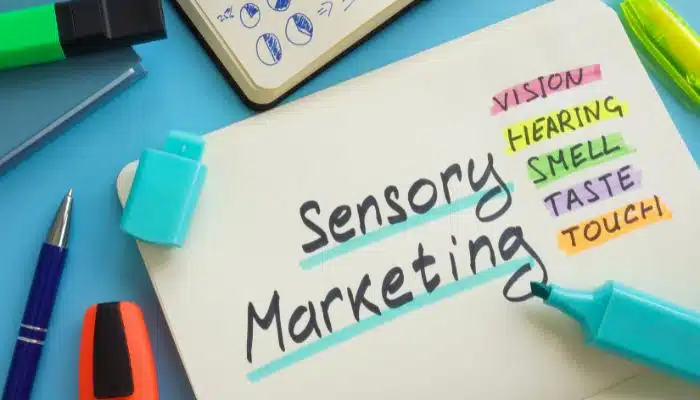Sensory marketing represents a revolution in the way brands interact with their consumers. This innovative approach goes beyond conventional strategies, appealing directly to the senses to create a memorable and emotionally resonant experience.
Sensory marketing is a powerful tool to stand out and forge a deep connection with your target audience. But what exactly is it and how can companies take advantage of it effectively?
In this article we tell you about its key principles and offer practical strategies to implement it successfully, thus transforming the way brands communicate and are perceived in the market.

Sensory marketing is a strategy that seeks to create a deeper and more emotional connection with consumers through their five senses: sight, hearing, touch, taste and smell.
The idea is to go beyond traditional marketing techniques, which focus mainly on the visual and auditory, to offer experiences that involve people’s senses in a more integral way.
The main objective of sensory marketing is to create an immersive and memorable brand experience that establishes a deep emotional connection with consumers.
By appealing to the senses in an integrated way, sensory marketing seeks to go beyond the simple commercial transaction to forge a lasting and meaningful relationship between the brand and its audience. The main objectives include:
Sensory marketing can be categorized into several types, each focused on a specific sense. These are the main types:

Sensory marketing requires careful planning and strategic implementation to be effective. Here are some key strategies that companies can employ:
Before implementing any sensory marketing strategy, it is crucial to understand who you are targeting. This includes knowing their preferences, behaviors and expectations.
Sensory stimuli must be aligned with the brand identity. For example, a luxury brand might use high-end materials for tactile marketing, while a nature-related brand might use natural sounds and scents.
The key to success in sensory marketing is the creation of an immersive experience that engages the customer. This can be achieved by using multiple senses in a coherent and complementary manner.
Delivering personalized experiences based on individual customer preferences can significantly increase the impact of sensory marketing.
The sensory experience must be consistent across all customer touch points, from the physical store to packaging to online advertising. This helps strengthen brand identity and customer loyalty.
Modern technology, such as virtual or augmented reality, can be used to create rich, immersive sensory experiences that would be impossible in the physical world.
As with any marketing strategy, it is important to measure the effectiveness of sensory marketing. Collect customer feedback and adjust strategy.
Don’t be afraid to experiment with new ideas and approaches to sensory marketing. What works for one brand may not work for another, and it is often the most innovative ideas that have the greatest impact.
Staff must be well trained in delivering the desired sensory experience. Your interaction with customers is often a crucial component of the overall experience.
In designing sensory experiences, it is important to consider sustainability and cultural sensitivity, ensuring that strategies are environmentally friendly and culturally appropriate.
Several successful examples of sensory marketing highlight how companies can use this strategy to enhance the customer experience and strengthen their brand:

It is known for its effective use of scent marketing. They maintain a consistent aroma of freshly brewed coffee in their stores, which not only attracts customers, but also reinforces their brand identity as a welcoming place to enjoy high quality coffee.

The touch experience is a key component in Apple stores. Products are arranged in such a way that customers can touch and try them, which increases the emotional connection with the products and enhances the perception of high quality and innovative design.

In its stores, Nike combines visual, tactile and auditory elements to create an immersive shopping experience. From energizing music to interactive zones where customers can touch and feel the materials, Nike seeks to inspire and motivate its customers.

It is famous for its use of olfactory and tactile marketing. They use a customized fragrance in their cabins and uniforms, along with high-quality bedding and seating, to enhance the flying experience and make it more memorable.
In conclusion, sensory marketing has established itself as a powerful and effective tool in the modern marketing arsenal. By focusing on the multi-sensory experience, brands can create deeper and more lasting emotional connections with their consumers.
If you need help to implement these marketing strategies, do not hesitate to contact us. In Kiwop, we have highly trained personnel to promote the development of your projects.
If you want to have the website you want or increase the online visibility of your brand, we know how to do it.
Shall we start today?
Leave a Reply